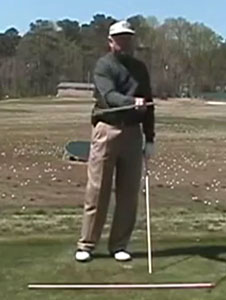
Should the right forearm be on the clubshaft
plane at impact?
Click here to go back to the video project's index page.
One of the fundamental principles of Homer Kelley's
TGM book is the idea that the right forearm should be on the clubshaft plane at
impact. Although I can understand why Homer Kelley believed that it was a very
desirable characteristic of an optimal golf swing action, I have noted that many
professional golfers do not have their right forearm on the same plane as their
clubshaft at impact. Although it may be optimal (from a TGM ideological
perspective) to have the right forearm on the
same plane as the clubshaft at impact, I personally believe that it is very acceptable to have the
right forearm positioned more horizontal, or more vertical, than the clubshaft
plane at impact; and before I explain why I believe that it is very acceptable, first
consider the fundamental reason why TGM literalists believe that the right
forearm should preferably be on the clubshaft plane at impact.
Lynn Blake, a renown TGM golf instructor, fervidly believes that the right forearm should be on the clubshaft plane at impact, and he teaches that TGM principle in his TGM golf instructional schools. Here is a you-tube video where Lynn Blake uses dowel sticks to demonstrate the TGM principle of having the right forearm on the clubshaft's plane at impact.
Dowels and wedges video - https://www.youtube.com/watch?v=c3kaU1QxHW8
Here is a capture image from the video.

Lynn Blake is holding a dowel stick in his right hand, and the dowel stick
represents the clubshaft. Lynn Blake believes that the right forearm must be on
the same plane as the clubshaft, and to acquire that specific alignment
condition, the
right wrist must always be level (and not upcocked or
downcocked) in order to always keep the right forearm and right
wrist (RFFW) on the same
plane as the clubshaft - not only at address and at impact, but theoretically at all times
during the backswing action and downswing action.
Here are capture images showing Lynn Blake demonstrating how the right forearm will be on the clubshaft plane at impact if a golfer always kept his right forearm on the same plane as the clubshaft throughout his entire downswing's "on-plane" swing action.
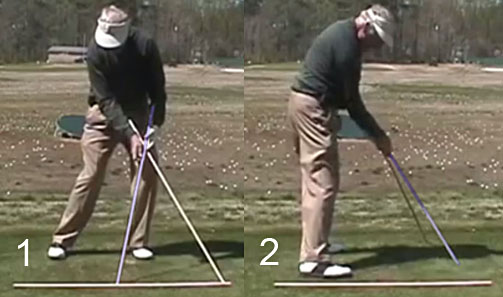
Image 1 is a face-on view, and image 2 is a DTL view, of Lynn Blake
demonstrating how the right forearm should be on the clubshaft plane at impact -
where the clubshaft is represented by the dowel stick, which I have tinted
blue-violet in color. The other dowel stick (in its natural light brown color)
is held along the longitudinal axis of the right forearm and its peripheral end
should point at the ball-target line at impact if the right forearm is
"on-plane" - remember that a golfer should theoretically be tracing the SPL (straight plane
line = ball-target line) throughout the downswing via PP#3, which is always
straight-in-line with the right forearm if the right wrist is always level, if
he wants to keep the clubshaft continuously "on-plane" throughout his entire
downswing action. Note
that Lynn Blake has a level right wrist (which means that it is not upcocked or
downcocked) to enable the right forearm to be on the same plane as the
clubshaft.
Here is another video featuring Lynn Blake, where he uses badminton racquets, to demonstrate the same TGM principle of an "on-plane" right forearm.
Flying wedges video - https://www.youtube.com/watch?v=RaEaA_TclXE
Here are capture images from the video showing Lynn Blake demonstrating the impact position with two badminton racquets.
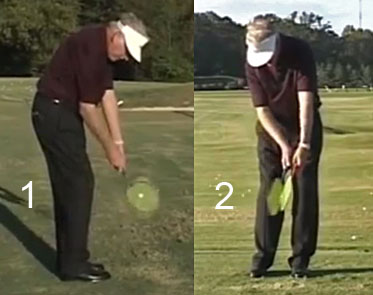
Note that the two badminton racquet faces are perfectly matched in terms of
their impact alignment when viewed from both a DTL view (image 1) or a face-on view
(image 2).
Note that Lynn Blake is using a low palmar left hand grip, and his left wrist is level at impact, which means that he will have a moderate sized accumulator #3 angle at impact, and his clubshaft will therefore not be in a straight-line alignment with his left arm (when viewed from a DTL perspective - see image 1). From a face-on viewing perspective, the clubshaft will be straight-line aligned with his left arm if he has an intact LAFW/GFLW alignment and slightly out-of-line if the left wrist is slightly bowed (as seen in image 2).
Note that Lynn Blake uses a mid-palmar grip alignment for his right hand, and that his right wrist is level (and not upcocked or downcocked), and with his right elbow in that particular position at impact, it will allow him to get his right forearm to lie on the same plane as the handle of the racquet held in his right hand if his right elbow straightens by the exact necessary amount.
What Lynn Blake doesn't discuss in these videos, is that to get this precise alignment of the right forearm relative to the clubshaft at impact, a golfer must also optimally keep his upper swing center stationary throughout the downswing action (and a stationary head is an useful marker for a stationary upper swing center) and he must also have the right shoulder in a very specific position at impact. Note that Lynn Blake does not acquire any right lateral bend during his downswing action, and note that his shoulders are relatively square to the ball-target line at impact. Finally, the right elbow must also be in very specific position at impact and the right arm must also be straightened to a very specific degree at the level of the right elbow joint.
In other words, to get the right forearm consistently on the same plane as the clubshaft at impact, a golfer must consistently fulfill a large number of biomechanical conditions during his downswing action - i) the upper swing center must not sway from side-to-side, or bob up-and-down, in an inconsistent manner during the downswing; ii) the right shoulder must always rotate around a rightwards-tilted spine that consistently has a certain amount of secondary axis tilt and the golfer must avoid acquiring too much right lateral bend that can move the right shoulder off-plane and too close to the ground; iii) the speed of upper torso rotation should be consistent from swing-to-swing so that the right shoulder always gets to the exact same downplane position at impact; iv) the right upper arm must consistently be at the same angle at impact in order to get the right elbow positioned correctly; v) the right elbow must have a consistent degree of bend at impact so that the right forearm's alignment angle relative to the right humerus is also optimally correct (which is biomechanically dependent on a consistent degree of right arm straightening during the late downswing); and vi) the right wrist must be level at impact.
Is there a professional golfer who can consistently achieve all these necessary biomechanical conditions during his downswing action, so that he can consistently get his right forearm onto his clubshaft plane at impact?
I think that Bryson DeChambeau is the PGA tour golfer who can best achieve all these necessary biomechanical conditions, that are needed to consistently get the right forearm to be on the clubshaft plane at impact.
DTL swing video of Bryson DeChambeau's iron swing - https://www.youtube.com/watch?v=QpuJhMF0ovU
Here are capture images from the video.

Image 1 shows Bryson DeChambeau at address. Note that he stands relatively
upright. Note that his left arm is outstretched away from his body. I have drawn
a red line down the length of his left arm and it shows that there is a small
angle between his clubshaft and that red line, which means that he has a small
accumulator #3 angle (because he uses a mid-palmar left hand grip). Note that
his right forearm is on the same plane as his clubshaft at address.
Image 2 is at P3, image 3 is at P4, image 4 is at P5 and image 5 is at impact. Note that he has a zero-plane shift golf swing and his club goes up, and then comes down, a relatively steep plane that is just below the TSP. Note that he has his shoulders only slightly open at impact and he does not acquire a significant amount of right lateral bend. Note that he keeps his head stationary and his head does not drop in his early downswing - as frequently seen in many PGA tour golfers (like Tiger Woods and Rory McIlroy) due to increased hip joint and knee joint flexion. Note that his arms are outstretched away from his body at impact to the same degree as it was at address. Note that his right forearm is on the clubshaft plane at impact. Note that Bryson DeChanbeau's right humerus is more outstretched away from his body (compared to Lynn Blake's more vertically-oriented right humerus in his capture images) because his clubshaft is on a steeper plane (due to the smaller accumulator #3 angle secondary to his adoption of a mid-palmar left hand grip).
Bryson DeChambeau is a devoted student of TGM ideology and his zero-plane shift swing is a perfect example of the TGM principles that allow a golfer to biomechanically standardise his golf swing action so that he can consistently get his right forearm on the same plane as the clubshaft at impact. Bryson DeChambeau has adopted the zero-plane shift TGM ideology to such an extreme degree that all his irons are of the same length, which means that he doesn't have to change his spinal bend inclination angle, or arm angles, when using a pitching wedge rather than a 4-iron.
Bryson DeChambeau even uses a robotic golfing machine to train himself to standardise his TGM-based zero-plane shift golf swing action - as demonstrated in the following video at http://www.golfcentraldaily.com/2016/01/bryson-dechambeau-has-monster-robot.html
Although I personally have no objection to having the right forearm on the plane of the clubshaft at impact (because it makes so much theoretical sense from a TGM perspective), I have noted that many superb PGA tour golfers do not manifest that biomechanical characteristic and I cannot identify any swing problems occurring as a result of their having their right forearm on either a flatter plane, or a steeper plane, than their clubshaft's plane at impact.
Consider an example of three PGA tour golfers at impact.
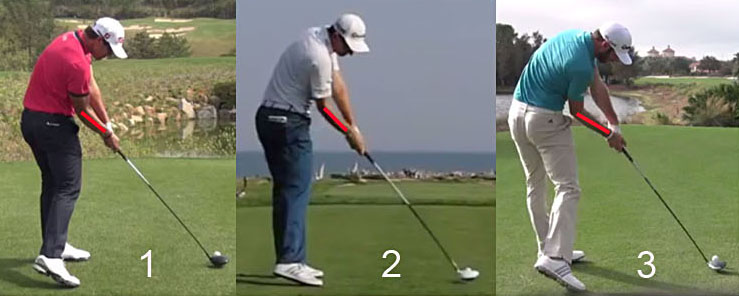
Image 1 = Adam Scott, image 2 = Justin Rose
and image 3 = Dustin Johnson.
I have drawn a red line down the length of their right forearm and you can see that their right forearm is on a flatter plane than their clubshaft's plane at impact. Note that they all have slight ulnar deviation of their right wrist, which means that their right wrist is not level. Note that one can see "air" between their right forearm and their left forearm because their right forearm is on a flatter plane than their left forearm. Note that they all have their left arm slightly outstretched at impact and that their clubshaft is on a plane that is roughly between the elbow plane and the TSP (which means that its plane-of-steepness is intermediate in its degree of steepness).
Why is their right forearm on a flatter plane than their clubshaft at impact?
I believe that it is due to the fact that they all acquire a significant amount of right lateral bend during their downswing action that moves their right shoulder much closer to the ground, and they also all have more open shoulders at impact - compared to Bryson DeChambeau and Lynn Blake. Dustin Johnson has the greatest amount of right lateral bend and one can note that his right forearm is much more horizontal (compared to Adam Scott's and Justin Rose's right forearm).
Now consider a golfer - Sergio Garcia - who has his right forearm on a steeper plane than his clubshaft's plane at impact.
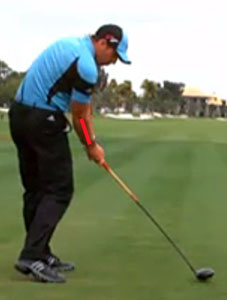
I have drawn a red line down the length of Sergio Garcia's right forearm and one
can clearly see that his right forearm is on a much steeper plane than his
clubshaft's plane at impact. Why is that phenomenon happening? The answer can easily be
discerned by carefully looking at his impact alignments - note that his hands
are very low and very close to his thighs at impact (secondary to the fact that
his left arm is much more vertically aligned and not outstretched at impact) and
note that he has a very large accumulator #3 angle due to the fact that his
clubshaft is on a very shallow plane (hand plane) at impact. Note that his right
wrist is radially deviated, and not level, at impact.
Here are further examples of PGA tour golfers, who have their right forearm on varying planes (relative to their clubshaft) at impact.

Image 1 = Alvaro Quiros, image 2 = J.B. Holmes, image 3 = Phil Mickelson, image 4 = Hunter Mahan, and image 5 = Keegan Bradley.
Note that Alvaro Quiros and J. B. Holmes have their right forearm on the same plane as their clubshaft impact. Note that Phil Mickelson's rear forearm is on a steeper plane than his clubshaft's plane at impact. Note that Hunter Mahan and Keegan Bradley have their right forearm on a flatter plane than their clubshaft's plane at impact. Note their different body/arm postural alignments at impact. For example, note that Phil Mickelson has a very small spinal bend inclination angle at impact, note his shoulders are relatively square to the ball-target line at impact and note that his rear shoulder is high due to the absence of left lateral bend. By contrast, note that Hunter Mahan and Keegan Bradley both have a large spinal bend inclination angle at impact, note that they both have a lot of right lateral bend that gets their right shoulder much lower than their left shoulder at impact, and note that their right upper arm is much more vertically aligned and not outstretched at impact (when compared to Phil Mickelson's rear upper arm).
There are many biomechanical elements that determine whether a golfer can get their right forearm on the clubshaft's plane at impact, and it is obvious that many PGA tour golfers have their right forearm on either a shallower plane, or a steeper plane, than their clubshaft's plane at impact. I personally suspect that the right forearm can still efficiently perform its essential functions during the downswing even if the right forearm is flatter, or steeper, than the clubshaft at impact - and those essential functions include i) allowing the RFFW to adequately support the intact LAFW on the inclined plane during the early-mid downswing; and ii) allowing the right palm to assist in the smooth release of PA#3 during the late downswing (by applying a finite amount of push-pressure against PP#1 located over the left thumb). Although it is theoretically advantageous to use PP#3 (which is where the right index finger abuts against the aft side of the club) to trace the SPL during the downswing, thereby synergistically helping a golfer to continuously maintain an "on-plane" clubshaft throughout the downswing action, it is patently obvious than many PGA tour golfers can maintain an "on-plane" clubshaft without any additional assistance from an "on-plane" right forearm where PP#3 is continuously straight-in-line with the right forearm due to the constant presence of a level right wrist.
Consider how easily Jim George (my model golfer for my video project) can maintain an intact LAFW and an "on-plane" clubshaft during his left arm-only swing action where he has no synergistic help from his right arm - watch this part 2 video ( https://www.youtube.com/watch?v=wJveJDoNzCw ) between the 36:18 - 36:35 minute time point.
Here are capture images from the video.

Image 1 is the end-backswing position. Note that he has an intact LAFW and an
"on-plane" clubshaft.
Image 2 is at the P5 position. Note that he has an intact LAFW and an "on-plane" clubshaft.
Image 3 is at the P5.5 position. Note that he has been shallowing his clubshaft down to the elbow plane during his early-mid downswing, but he still has an intact LFFW and an "on-plane" clubshaft.
Image 4 is at impact where he has an intact LAFW and an "on-plane" clubshaft.
It is not that difficult for a skilled amateur golfer to learn how to i) maintain an intact LAFW and learn how to ii) keep the clubshaft "on-plane" throughout the entire downswing even without any help from the right arm - so tracing the SPL with PP#3 (which is situated where the right index finger abuts against the aft side of the club handle) is not an absolutely essential requirement.
Summary: I can certainly agree with a "belief" that having the right forearm on the clubshaft's plane at impact is theoretically desirable from a TGM perspective, but I do not believe that it should be perceived to be a mandatory imperative, that is absolutely essential if a golfer wants to perform a high quality TGM-swinging action like a PGA tour golfer. Many PGA tour golfers have their right forearm on a slightly steeper plane, or a slightly shallower plane, than the clubshaft's plane at impact (for a complex variety of reasons) and amateur golfers should not rigidly believe that their right forearm must always be on the clubshaft's plane at impact (simply because it is a fundamental TGM concept that many TGM-authorised golf instructors frequently teach).
Jeffrey Mann.
February 2017.